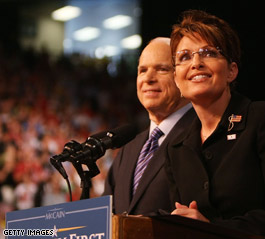
John McCain claims that he understands women's issues and needs, but a closer look at his views on insurance and medical care show a different story. Below is a recent New York Times article that explains the problems that have/will undoubtedly rise from McCain's healthcare plans that include great investment in individual insurance plans.
WASHINGTON — Striking new evidence has emerged of a widespread gap in the cost of health insurance, as women pay much more than men of the same age for individual insurance policies providing identical coverage, according to new data from insurance companies and online brokers.
Some insurance executives expressed surprise at the size and prevalence of the disparities, which can make a woman’s insurance cost hundreds of dollars a year more than a man’s. Women’s advocacy groups have raised concerns about the differences, and members of Congress have begun to question the justification for them.
The new findings, which are not easily explained away, come amid anxiety about the declining economy. More and more people are shopping for individual health insurance policies because they have lost jobs that provided coverage. Politicians of both parties have offered proposals that would expand the role of the individual market, giving people tax credits or other assistance to buy coverage on their own.
“Women often fare worse than men in the individual insurance market,” said Senator Max Baucus, Democrat of Montana and chairman of the Finance Committee.
Insurers say they have a sound reason for charging different premiums: Women ages 19 to 55 tend to cost more than men because they typically use more health care, especially in the childbearing years.
But women still pay more than men for insurance that does not cover maternity care. In the individual market, maternity coverage may be offered as an optional benefit, or rider, for a hefty additional premium.
Crystal D. Kilpatrick, a healthy 33-year-old real estate agent in Austin, Tex., said: “I’ve delayed having a baby because my insurance policy does not cover maternity care. If I have a baby, I’ll have to pay at least $8,000 out of pocket.”
In general, insurers say, they charge women more than men of the same age because claims experience shows that women use more health care services. They are more likely to visit doctors, to get regular checkups, to take prescription medications and to have certain chronic illnesses.
Marcia D. Greenberger, co-president of the National Women’s Law Center, an advocacy group that has examined hundreds of individual policies, said: “The wide variation in premiums could not possibly be justified by actuarial principles. We should not tolerate women having to pay more for health insurance, just as we do not tolerate the practice of using race as a factor in setting rates.”
Without substantial changes in the individual market, Ms. Greenberger said, tax credits for the purchase of insurance will be worth less to women because they face higher premiums.
The disparities are evident in premiums charged by major insurers like Humana, UnitedHealth, Aetna and Anthem, a unit of WellPoint; in prices quoted by eHealth, a leading online source of health insurance; and in rate tables published by state high-risk pools, which offer coverage to people who cannot obtain private insurance.
Humana, for example, says its Portrait plan offers “ideal coverage for people who want benefits like those provided by big employers.” For a Portrait plan with a $2,500 deductible, a 30-year-old woman pays 31 percent more than a man of the same age in Denver or Chicago and 32 percent more in Tallahassee, Fla.
In Columbus, Ohio, a 30-year-old woman pays 49 percent more than a man of the same age for Anthem’s Blue Access Economy plan. The woman’s monthly premium is $92.87, while a man pays $62.30. At age 40, the gap is somewhat smaller, with Anthem charging women 38 percent more than men for that policy.
Todd A. Siesky, a spokesman for WellPoint, declined to comment on the Anthem rates.
Thomas T. Noland Jr., a senior vice president of Humana, said: “Premiums for our individual health insurance plans reflect claims experience — the use of medical services — which varies by gender and age. Females use more medical services than males, and this difference is most pronounced in young adults.”
In addition, Mr. Noland said, “Bearing children increases other health risks later in life, such as urinary incontinence, which may require treatment with medication or surgery.”
Most state insurance pools, for high-risk individuals, also use sex as a factor in setting rates.
Thus, for example, in Dallas or Houston, women ages 25 to 29 pay 39 percent more than men of the same age when they buy coverage from the Texas Health Insurance Risk Pool.
In Nebraska, a 35-year-old woman pays 32 percent more than a man of the same age for coverage from the state insurance pool.
Representative Xavier Becerra, Democrat of California, said that “if men could have kids,” such disparities would probably not exist.
Elizabeth J. Leif, a health insurance actuary in Denver who helps calculate rates for Nebraska and other states, said: “Under the age of 55, women tend to be higher utilizers of health care than men. I am more conscious of my health than my husband, who will avoid going to the doctor at all costs.”
“Many state insurance laws require insurance policies to cover complications of pregnancy, even if they do not cover maternity care,” Ms. Leif said. Insurers say those complications generate significant costs.
Representative Lloyd Doggett, Democrat of Texas, asked, “How can insurers in the individual market claim to meet the needs of women if maternity coverage is so difficult to get, so inadequate and expensive?”
Cecil D. Bykerk, president of the Society of Actuaries, a professional organization, said that if male and female premiums were equalized, women would pay less but “rates for men would go up.”
Mr. Bykerk, a former executive vice president of Mutual of Omaha, said, “If maternity care is included as a benefit, it drives up rates for everybody, making the whole policy less affordable.”
The individual insurance market is notoriously unstable. Adults often find it difficult or impossible to get affordable coverage in this market. In most states, insurers can charge higher premiums or deny coverage to people with health problems.
In job-based coverage, civil rights laws prohibit sex discrimination. The Equal Employment Opportunity Commission says employers cannot charge higher premiums to women than to men for the same benefits, even if women as a class are more expensive. Some states, including Maine, Montana and New York, have also prohibited sex-based rates in the individual insurance market.
Mila Kofman, the insurance superintendent in Maine, said: “There’s a strong public policy reason to prohibit gender-based rates. Only women can bear children. There’s an expense to that. But having babies benefits communities and society as a whole. Women should not have to bear the entire expense.”
And that expense can be substantial.
In Iowa, a 30-year-old woman pays $49 a month more than a man of the same age for one of Wellmark’s Select Enhanced plans. Her premium, at $151, is 48 percent higher than the man’s.






